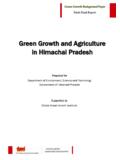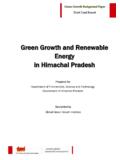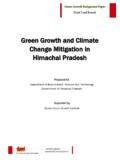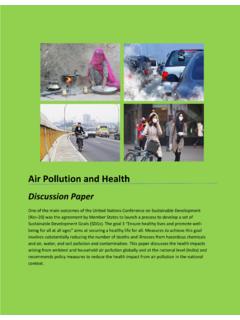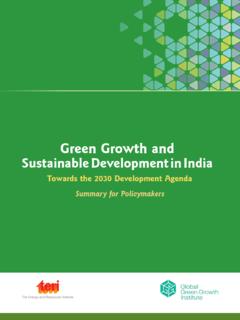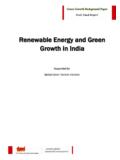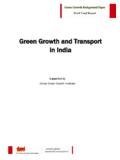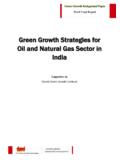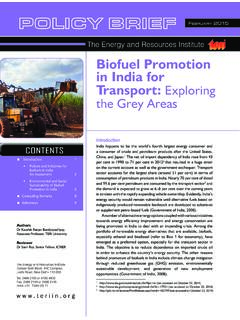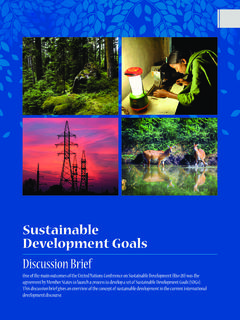Transcription of Green Growth and Hydro Power in Himachal Pradesh
1 I Prepared for Department of Environment, Science and Technology Government of Himachal Pradesh Supported by Global Green Growth Institute Green Growth and Hydro Power in Himachal Pradesh Draft Final Report Green Growth and Hydro Power in Himachal Pradesh ii The Energy and Resources Institute 2015 Suggested format for citation T E R I. 2015. Green Growth and Hydro Power in Himachal Pradesh . New Delhi: The Energy and Resources Institute. 11 pp. Author Sw ati Mitch elle D Sou za, Research Associate, TERI Email: Jon ath an Don ald Syiem lieh, Associate Fellow, TERI Email: Review er S Vijay Ku m ar, Distin gu ish ed Fellow , TERI Email: SV For more information Project Monitoring Cell T E R I Tel.
2 2468 2100 or 2468 2111 Darbari Seth Block E-mail IHC Complex, Lodhi Road Fax 2468 2144 or 2468 2145 New Delhi 110 003 Web i i India India +91 Delhi (0)11 3 Table of Contents 1. Introduction .. 1 2. Hydropower in Himachal Pradesh .. 1 H yd rop ow er d evelop m en 1 H yd rop ow er Poten tial .. 2 3. Policy interventions .. 3 4. Interventions for Green Growth .. 4 Clean Develop m en t Mech an ism .. 4 Com p en satory Afforestation Fu n d Man agem en t an d Plan nin g Au th ority .. 5 Catch m en t Area Treatmen t & Sed im en tation Rem oval .. 6 5. Ways forward .. 10 6. Bibliography .. 11 List of Tables Table 1 The basin wise capacities of Himachal Pradesh .
3 2 Table 2 Total identified hydropower potential in Himachal Pradesh (in MW) .. 3 Table 3 Projects applied for CDM in Himachal Pradesh .. 5 Table 4 Sector-wise break-up of Approved APO for 2012-13 for Himachal Pradesh .. 6 Table 5 Cost estimate for CAT- Biological Measures (Vishnu Pipalkoti HEP) .. 7 Table 6 Cost estimate for CAT - Engineering Measures (Vishnu Pipalkoti HEP).. 8 1 1. Introduction Hydropower is the second most important source of energy and accounts for of the total installed capacity of MW as on 28th Feb, 2015 (CEA, 2014). India accounted for of the global installed capacity and ranked 6th in the list of global nations for hydropower capacity and generation with a net installed capacity to the tune of GW (REN 21, 2014).
4 The importance of hydropower has gained wide popularity with the focus of moving away from fossil fuel generation dependence. Hydropower is considered a cleaner and greener source for generation of electricity compared to other energy sources. The significance of hydropower generation is described briefly below. Hydropower is unique as it is a clean source of energy, renewable and Green as compared to fossil fuel generation Power plants. It does not cause air pollution nor does it burn any fuel with near zero emissions. Hydropower is relatively cleaner as compared to other sources of energy and the emission rate per unit of electricity generated from hydropower excluding tropical reservoirs is way below than emission rates for fossil fuel technologies (Steinhurst, Knight, & Schultz, 2012).
5 In comparison to other renewables on a life cycle basis, GHG emissions release from hydropower is lesser relative to that of electricity generation from biomass and solar. The emissions are almost equivalent to those from wind, nuclear and geothermal Power plants. Since hydropower generation does not require burning or combustion of any fuels, the cost of operation are not susceptible to market price fluctuations. Unlike other sources of energy, hydropower generation provides an abundance of unique benefits which can be those emanating from the generation of electricity itself or from side benefits associated with hydropower reservoirs.
6 Such benefits can include a secure water supply, irrigation and flood control including increased navigation and increased recreational opportunities. There can be scope for development of fisheries and cottage and small scale industries. Multipurpose hydropower projects also help in subsidizing other major features of the project such as those indicated above. In spite of recent debates sparking greenhouse gas emissions from reservoir based hydropower projects, hydropower generation is still a relatively cleaner source of energy in comparison to fossil based generation 2. Hydropow er in Himachal Pradesh H yd rop ow er d evelop m en t Hydropower exploitation in Himachal Pradesh began even before it was a full-fledged state with the commissioning of a MW HEP by the Raja of Chamba in 1908.
7 There were couple of other small projects that were executed like the 110 MW Shanan HEP in mandi district and the 60 MW HEPs each of Bassi and Giri (Department of Environment, Science and Technology, Government of Himachal Pradesh , 2005). In the late 50 s and early 60 s, the ersthwhile Punjab government started the construction of Shansha and Billing HEPs in Lahaul and Spiti. Green Growth and Hydro Power in Himachal Pradesh 2 H yd rop ow er Potential Himachal Pradesh has a generation potential of 23 GW as per preliminary hydrological, topographical and geological investigations and out of which only MW has been exploited by various agencies across the state which also include MW by HPSEBL1.
8 Five major snow fed rivers emanating from the Western Himalayas flow within Himachal Pradesh include Ravi, Chenab, Satluj, Beas and Yamuna. These snow-fed rivers and their tributaries carry abundant discharge all the year round which can be exploited for Power generation. The basin wise capacities have been indicated in the table 1 below: Table 1 Th e basin w ise cap acities of H im ach al Prad esh N ame of Projects Capacity (MW) Yam u n a 794 Satlu j 10,226 Beas 5,721 Rav i 2,912 Ch en ab 3,037 Self-Id en tified / N ew Id en tified 310 Total 23,000 Source: (Econ om ics an d Statistics Dep artm en t, Govern m en t of H im ach al Prad esh , 2014) Out of the total identified hydropower potential for the state, 3783 MW has been allotted to the state agents namely, HPSEBL/ HPPCL2 while 9089 MW has been allocated to Central actors and Joint venture route while the remaining has been assigned to the private sector for development and construction as indicated in the table 2 below.
9 1 H im ach al Prad esh State Electr icity Board Lim ited 2 H im ach al Prad esh Pow er Corp oration Lim ited 3 Table 2 Total id en tified h yd rop ow er p otential in H im ach al Prad esh (in MW) Sr. N o. Particulars State Sector HPSEBL/ HPPCL (MW) Central/Joint Sector/HP Share (MW) Private Sector Total (MW) Above 5MW Up to 5 MW (th rou gh H IMURJA) 1. Projects Com m ission ed 478 5,903 1,829 222 8,432 2. Un d er Execu tion / Con stru ction 966 2,532 765 179 4,442 3. Un d er Im p lem en tation / Obtain in g Clear an ce 1,285 66 866 365 2,582 4. Un d er In vestigation 1,034 588 3,340 510 5,472 5. Un d er Litigation / d isp u te -- -- 1,007 -- 1007 6.
10 Aban d on ed sch em es in view of en vir on m en tal & social con cern s 20 -- 735 -- 755 7. To be allotted -- -- 310 -- 310 TOTAL 3,783 9,089 8,852 1,276 23,000 Source: (Econ om ics an d Statistics Dep artm en t, Govern m en t of H im ach al Prad esh , 2014) 3. Policy interventions The HP state government formulated the Hydro Power Policy in 2006 to accelerate the Growth of the sector with a more inclusive Growth and strengthen local participation in project execution, operation and maintenance. In line with the National Hydropower policy 2008, the state government have introduced a provision where hydropower developers shall provide an additional free Power post the commissioning of the HEPs at the rate of 1% of the generated energy from all hydel Power projects which would be earmarked for Local Area Development Fund (LADF).
